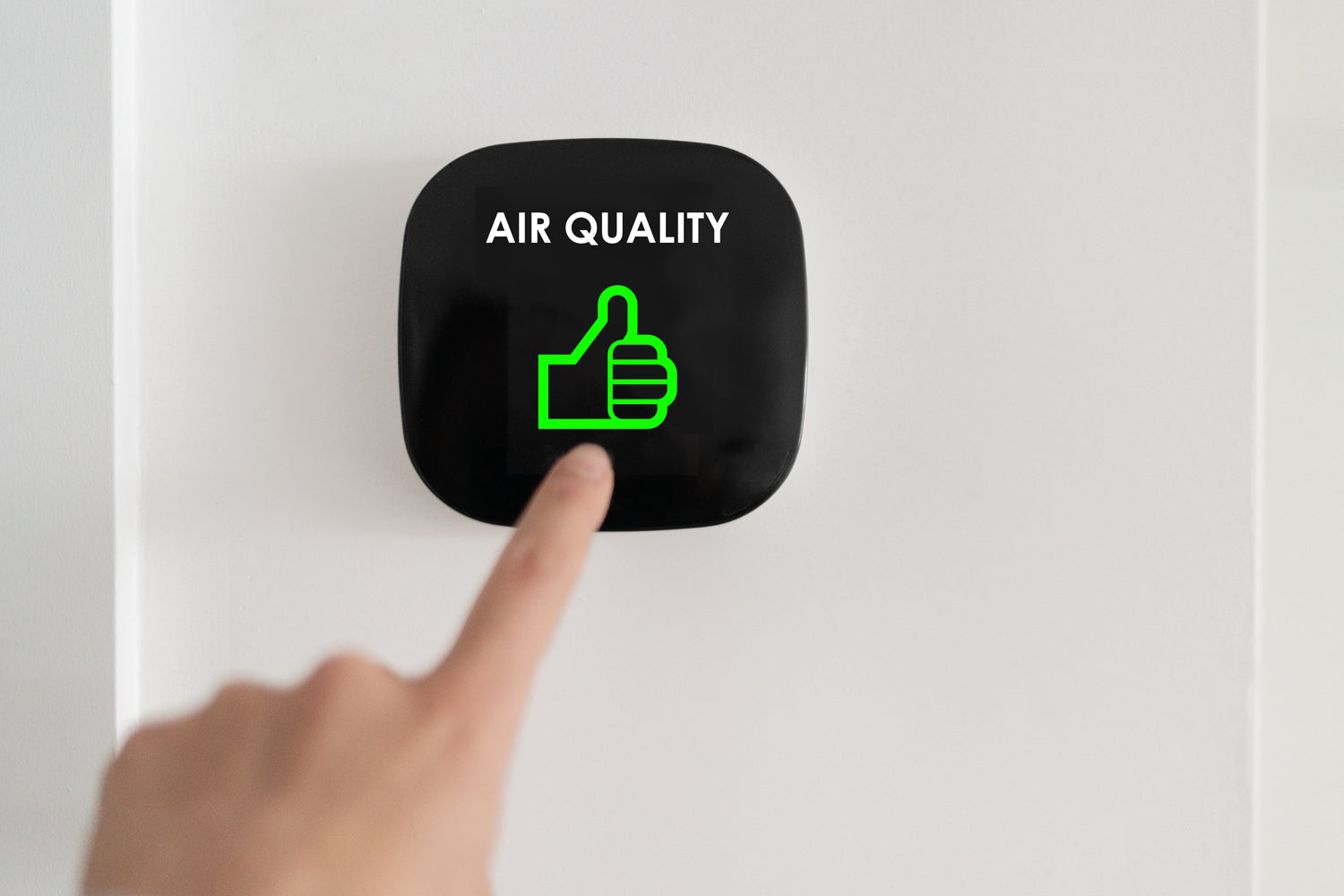Air quality measurement devices are versatile devices that can be used in a wide variety of areas. The main purpose of these devices is to monitor the air quality in the environment and to detect the level of pollutants and ensure that precautions are taken. Here are the common areas of use of air quality measurement devices:
1. Indoor Air Quality Monitoring in Homes and Offices
Air quality in home and office environments is very important in terms of comfort and health. These devices monitor the levels of carbon dioxide (CO2), volatile organic compounds (VOC), particulate matter (PM2.5) and humidity in indoor areas. Keeping air quality under control can help improve the quality of life, especially for people with allergies, asthma and other respiratory problems.
2. Schools and Educational Institutions
Air quality in schools and other educational institutions can affect the concentration and general health of students and teachers. Fatigue and lack of attention can be seen, especially when CO2 levels are high. Air quality measurement devices help to ensure healthy air conditions in the classroom environment.
3. Healthcare Institutions and Hospitals
Air quality in hospitals and health centers can directly affect the recovery process of patients. These devices can help maintain a sterile and healthy environment, reducing the risk of infection and allowing patients to recover faster.
4. Industrial and Manufacturing Facilities
Workers in industrial facilities may come into contact with harmful gases, dust, and chemicals. Air quality measurement devices are used to ensure the safety of workers and monitor air pollution levels in the workplace. These devices also ensure that businesses comply with legal regulations.
5. City Air Quality Monitoring
Air pollution is common in large cities, especially due to traffic, industry, and other pollution sources. Municipalities and environmental organizations use these devices to constantly monitor air quality and inform citizens. Monitoring air quality throughout the city helps protect especially sensitive groups (children, the elderly, asthmatics).
6. Smart Home Systems
Air quality sensors can be integrated into smart home systems and used with home automation. For example, when sensors detect deteriorating air quality, they can automatically open windows or activate ventilation systems.
7. Agriculture and Greenhouses
Air quality measurement in agricultural areas and greenhouses allows monitoring of factors that directly affect plant development. Keeping parameters such as CO2, humidity and temperature under control can ensure that plants grow efficiently and healthily.
8. Vehicles and Transportation
Indoor air quality sensors are used in modern vehicles and ventilation systems are automatically activated when air pollution is detected. In addition, these devices are used in public transportation vehicles and airplanes to ensure that passengers travel in a healthier environment.
9. Hotels and Restaurants
Air quality is of great importance in terms of customer satisfaction and hygiene in hotels, restaurants and similar businesses. Good indoor air quality increases the comfort of customers and provides a better experience. It also helps prevent harmful gases and odors that may occur in kitchens and closed areas.
10. Laboratories and Research Centers
Air quality sensors are used when conducting sensitive experiments and research in laboratory environments. These devices play an important role in sensitive environments where the air must remain clean and stable.
11. Gyms and Fitness Centers
CO2 levels can rise rapidly in closed areas where intense exercise is performed, which can negatively affect the performance of users. Air quality sensors are used to ensure that ventilation works effectively in such environments and to protect the health of athletes.
12. Camping and Caravans
When staying in campsites or caravans for a long time, the air quality of closed areas is of great importance. Especially in small and closed areas, there is a risk of carbon monoxide or other harmful gases accumulating. Air quality measurement devices help to provide a safe living space in such cases.
Conclusion
Air quality measurement devices are used in various areas to improve the quality of life and protect health. Thanks to these devices, health risks related to air pollution can be detected in advance and healthier and safer environments can be created by taking appropriate measures.
1. Indoor Air Quality Monitoring in Homes and Offices
Air quality in home and office environments is very important in terms of comfort and health. These devices monitor the levels of carbon dioxide (CO2), volatile organic compounds (VOC), particulate matter (PM2.5) and humidity in indoor areas. Keeping air quality under control can help improve the quality of life, especially for people with allergies, asthma and other respiratory problems.
2. Schools and Educational Institutions
Air quality in schools and other educational institutions can affect the concentration and general health of students and teachers. Fatigue and lack of attention can be seen, especially when CO2 levels are high. Air quality measurement devices help to ensure healthy air conditions in the classroom environment.
3. Healthcare Institutions and Hospitals
Air quality in hospitals and health centers can directly affect the recovery process of patients. These devices can help maintain a sterile and healthy environment, reducing the risk of infection and allowing patients to recover faster.
4. Industrial and Manufacturing Facilities
Workers in industrial facilities may come into contact with harmful gases, dust, and chemicals. Air quality measurement devices are used to ensure the safety of workers and monitor air pollution levels in the workplace. These devices also ensure that businesses comply with legal regulations.
5. City Air Quality Monitoring
Air pollution is common in large cities, especially due to traffic, industry, and other pollution sources. Municipalities and environmental organizations use these devices to constantly monitor air quality and inform citizens. Monitoring air quality throughout the city helps protect especially sensitive groups (children, the elderly, asthmatics).
6. Smart Home Systems
Air quality sensors can be integrated into smart home systems and used with home automation. For example, when sensors detect deteriorating air quality, they can automatically open windows or activate ventilation systems.
7. Agriculture and Greenhouses
Air quality measurement in agricultural areas and greenhouses allows monitoring of factors that directly affect plant development. Keeping parameters such as CO2, humidity and temperature under control can ensure that plants grow efficiently and healthily.
8. Vehicles and Transportation
Indoor air quality sensors are used in modern vehicles and ventilation systems are automatically activated when air pollution is detected. In addition, these devices are used in public transportation vehicles and airplanes to ensure that passengers travel in a healthier environment.
9. Hotels and Restaurants
Air quality is of great importance in terms of customer satisfaction and hygiene in hotels, restaurants and similar businesses. Good indoor air quality increases the comfort of customers and provides a better experience. It also helps prevent harmful gases and odors that may occur in kitchens and closed areas.
10. Laboratories and Research Centers
Air quality sensors are used when conducting sensitive experiments and research in laboratory environments. These devices play an important role in sensitive environments where the air must remain clean and stable.
11. Gyms and Fitness Centers
CO2 levels can rise rapidly in closed areas where intense exercise is performed, which can negatively affect the performance of users. Air quality sensors are used to ensure that ventilation works effectively in such environments and to protect the health of athletes.
12. Camping and Caravans
When staying in campsites or caravans for a long time, the air quality of closed areas is of great importance. Especially in small and closed areas, there is a risk of carbon monoxide or other harmful gases accumulating. Air quality measurement devices help to provide a safe living space in such cases.
Conclusion
Air quality measurement devices are used in various areas to improve the quality of life and protect health. Thanks to these devices, health risks related to air pollution can be detected in advance and healthier and safer environments can be created by taking appropriate measures.





Leave a comment
This site is protected by hCaptcha and the hCaptcha Privacy Policy and Terms of Service apply.